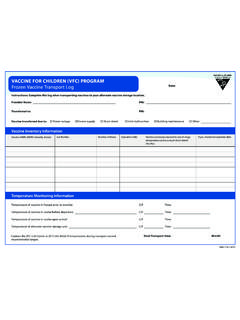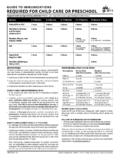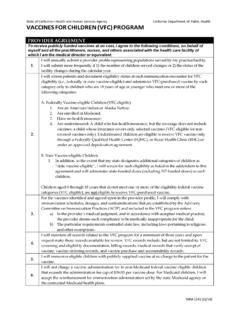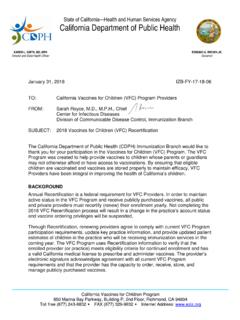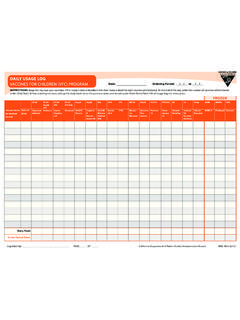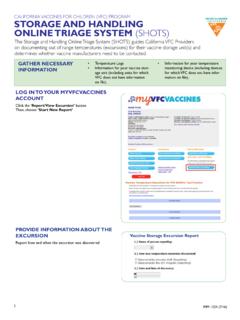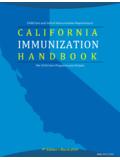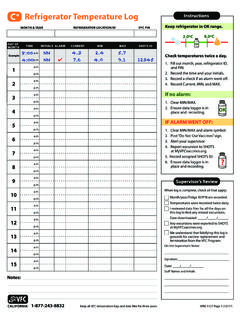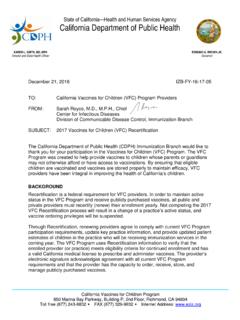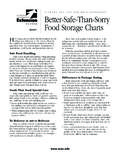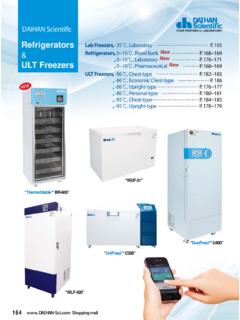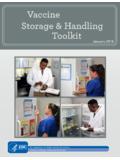Transcription of I, on behalf of myself and any and all practitioners ...
1 I, on behalf of myself and any and all practitioners associated with this medical office, group practice, Health Maintenance Organization (HMO), health department, community/migrant/rural clinic, hospital, or other entity of which I am the physician-in-chief, medical director or equivalent, agree to comply with all VFC Program requirements listed below. 1. Vaccine Management Plan A. Maintain a current and completed vaccine management plan (IMM-1122) for routine and emergency situations that includes practice-specific vaccine management guidelines and protocols, names of staff with temperature monitoring responsibilities, and required EZIZ lesson completion dates for all key practice staff.
2 B. Review and update the plan at least once a year, when VFC Program requirements change, and when staff with designated vaccine management responsibilities change. C. Designate a staff member responsible for updating the management plan; ensure staff with assigned vaccine management responsibilities review, sign, and date the vaccine management plan annually and each time it is updated. D. The vaccine management plan must be easily accessible, ideally near the vaccine storage units. E. Conduct regular vaccine management drills to maintain competency and readiness for emergency procedures, such as vaccine transport.
3 2. Training & Staffing A. Designate an on-site Provider of Record Designee authorized to sign VFC Program documents and assume responsibility for VFC-related matters in the absence of the Provider of Record. B. Designate fully trained on-site Vaccine Coordinator and Backup Vaccine Coordinator as detailed in "Vaccine Coordinator Roles & Responsibilities" (IMM-968). C. Ensure Provider of Record and Designee, Vaccine Coordinator and Backup, and other key practice staff comply with federal VFC educational requirements, such as annual EZIZ trainings; ensure staff demonstrate competency in their assigned VFC responsibilities.
4 D. Ensure staff, including supervisors and new employees, are properly trained on temperature monitoring, including proper use of the practice's temperature monitoring devices and the required corrective actions for out-of-range temperatures. E. Ensure staff authorized to accept packages are trained to immediately notify the Vaccine Coordinator when vaccines are delivered. F. Immediately report to the VFC Program any changes in key practice staff who have immunization-related responsibilities; a change in the Provider or Record or Designee requires a signed Key Practice Staff Change Request Form (IMM-1166).
5 G. Ensure that staff are knowledgeable of and familiar with ACIP-recommended immunizations, including schedules, indications, dosages, and new products. 3. Vaccine Storage Units A. Use only refrigerators or freezers that comply with VFC vaccine storage unit requirements. Very high volume providers must use pharmacy- or biologic-grade refrigerators. Other providers may use refrigerators and freezers that are pharmacy- or biologic-grade, commercial-grade, and household-grade stand-alone. B. Never use any of the following for vaccine storage: household-grade combination refrigerator-freezers, compact household-grade stand-alone refrigerators (with capacity 11 cubic feet or less), dormitory-style or bar-style 1 IMM-1242 (12/17).
6 Combination refrigerator/freezers, manual defrost refrigerators, convertible units, cryogenic (ultra-low) freezers, or any vaccine transport unit for routine storage (including coolers and battery-operated units). C. Dedicate vaccine refrigerators and freezers to the storage of vaccines only; if storage of medications or biologics is necessary, store below vaccines on a different shelf. D. Purchase new vaccine refrigerators or freezers if existing storage units do not meet VFC Program requirements, or in the event of storage unit malfunctioning that resulted in spoiled vaccines.
7 4. Digital Data Loggers (Continuous Temperature Monitoring Devices). A. Use or purchase data loggers that comply with VFC temperature monitoring device requirements: one device for each vaccine storage unit plus at least one backup device; ensure each device has a valid certificate of calibration (IMM-1119). B. Never use these devices for vaccine temperature monitoring: thermometers ( , round dial thermometers, fluid-filled and/or min-max bar thermometers, household-use and kitchen thermometers, infrared temperature guns, alcohol or mercury thermometers, and bi-metal stem thermometers); chart recorders; or data loggers with probes that aren't immersed in a vial filled with liquid, loose media, or a solid block of material.
8 C. Purchase and use digital data loggers to monitor vaccine storage unit temperatures upon expiration of the certificate of calibration of the current device (primary and backups). D. Ensure all data loggers include the following minimum features: a digital display of current, minimum, and maximum temperatures; minimum accuracy of F ( C); a buffered temperature probe (use only the one that comes with the device) immersed in a vial filled with up to 60mL liquid ( , glycol, ethanol, glycerin), loose media ( , sand, glass beads), or a solid block of material ( , Teflon , aluminum); an out-of-range temperature alarm; logging interval of at least 30 minutes; and memory storage of 4,000 readings or more.
9 E. Replace with digital data loggers any primary or backup thermometers deemed no longer accurate within + F (+ C). F. Store the backup device's buffered probe in the vaccine storage unit; store the digital display in a cabinet and document its location on the practice's vaccine management plan (IMM-1122). G. Calibrate primary and backup devices (device and probe) annually, or every other year when manufacturers recommend a period longer than two years ideally by a laboratory with accreditation from an ILAC MRA. signatory body. H. Ensure certificates issued by non-accredited laboratories are valid certificates of calibration (IMM-1119).
10 I. Keep certificates of calibration on file and make them available to VFC Field Representatives upon request. J. If data logger or probe is damaged, replace the entire device, or the damaged part if done through the device manufacturer. 5. Vaccine Refrigerator & Freezer Configuration A. Prepare vaccine refrigerators (IMM-962) and vaccine freezers (IMM-965) following VFC Program requirements. B. Place water bottles in vaccine refrigerators and ice packs in vaccine freezers to stabilize temperatures. C. Place buffered probes in the center of the refrigerator and freezer near vaccines.
